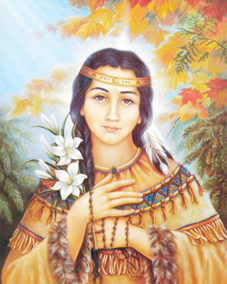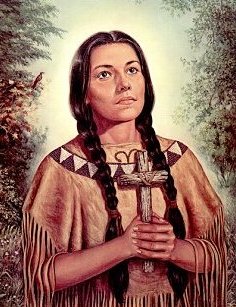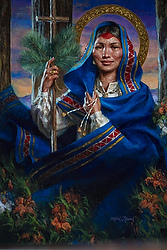
Summary: Kateri Tekakwitha was the daughter of a Mohawk chief and Kahenta, a woman of the Alonquin tribe who had found Christ through the evangelisation done by the Jesuit priests in what is now upstate New York. She is the first native North American to be beatified.
Fr John Murray tells her story.
 Kateri Tekakwitha – it’s quite a mouthful, isn’t it? The first time I came across this beautiful name was about twenty years ago. A little girl in a Confirmation class had chosen it. Among all the Bernadettes and Patricks, she had picked Kateri. I had to admit I had never heard of her. Initially I was a little suspicious it was the name of a film star, and not the name of a saint as I had suggested. I was soon put right by the little girl who had chosen so thoughtfully this name from a far country.
Kateri Tekakwitha – it’s quite a mouthful, isn’t it? The first time I came across this beautiful name was about twenty years ago. A little girl in a Confirmation class had chosen it. Among all the Bernadettes and Patricks, she had picked Kateri. I had to admit I had never heard of her. Initially I was a little suspicious it was the name of a film star, and not the name of a saint as I had suggested. I was soon put right by the little girl who had chosen so thoughtfully this name from a far country.
Born
In 1656 an Indian girl was born to a warrior chief and a Christian near the Mohawk river in what is today upstate New York. Her name was ‘Tekakwitha’, which can be translated as ‘putting things right’. Her father had married Kahenta during the conquest of her Alconquin tribe. Kahenta had found Christ through the evangelization work done by the Jesuits. However she had to keep her faith quiet, and so she prayed in secret with another Christian woman. Indeed another translation of her name was ‘the one who walks groping for her way’.
When she was four, Tekakwitha’s entire family died of smallpox; only the little girl survived. She was taken care of by Anastasia, her mother’s Christian friend. Sadly though, as a result of the disease, she herself was left with a pockmarked face, poor eyesight and weakened legs. These marks isolated her from the other Mohawk women but in a way prepared her for the joy of finding Christ whom she came to know loved her unconditionally. Some members of her tribe said that Sonkwaiatison, the Creator, had left her in darkness for her to see His light.
Early convrsion
Tekakwitha was already becoming a Christian by desire during her later childhood and teenage years. A treaty between the French and the Iroquois tribe allowed some Jesuits to come to her village and preach. Her uncle did not like the ‘Blackrobe’ and his strange new religion but he tolerated the missionary’s presence.
Kateri remembered her mother’s whispered prayers and was fascinated by the stories she heard of Jesus. She wanted to learn more. The priest, Fr de Lamberville, persuaded her uncle to allow Tekakwitha to attend the religious classes, and the following Easter at the age of twenty, she was baptized.
New Name
She took the name Kateri which is Mohawk for Catherine. However this step and her newfound joy did not endear her to the other members of her tribe. She was often scorned and persecuted. For instance, her family refused her food on Sundays because she would not work on that day. Sometimes children would taunt her and throw stones.
 Finally a priest arranged that she should escape to Canada to live there with other Christians. She made her way to the area around the great St. Lawrence River. She spent her time near modern-day Montreal helping the old and the sick and teaching the children. She made her first Holy Communion on Christmas Day, 1677.
Finally a priest arranged that she should escape to Canada to live there with other Christians. She made her way to the area around the great St. Lawrence River. She spent her time near modern-day Montreal helping the old and the sick and teaching the children. She made her first Holy Communion on Christmas Day, 1677.
Although not formally educated and unable to read or write, Kateri led a life of prayer and penance. Her favourite devotion was to make crosses out of sticks and place them throughout the woods where she lived. They reminded passers-by to spend a moment in prayer.
Kateri and the Bl. Sacrament
She herself would often spend hours before the Blessed Sacrament, kneeling in the cold chapel by herself. When the winter season took many of the villagers away on hunting expeditions she would be left to erect her own little chapel in the woods by carving a cross on a tree and spending time there in prayer.
Sometimes it can take decades for God to make a man or woman into a saint. Our fallen nature and its obstinacy is like Jacob wrestling with God. Sometimes God makes a saint very quickly just to show us how easy it is to be so. Such was the case with Kateri.
Once a priest asked the people why they gathered around her in church. They told him that they felt close to God when Kateri prayed. Her face changed when she prayed and became full of peace and beauty, as if she were looking at the face of God Himself.
 Today physical beauty is so prized among girls and women, and among men too, that those less favoured by nature can have difficulty believing that they are beautiful or that anyone could love them. In spite of her own weak body and marked face, Kateri radiated a real inner beauty to everyone she met.
Today physical beauty is so prized among girls and women, and among men too, that those less favoured by nature can have difficulty believing that they are beautiful or that anyone could love them. In spite of her own weak body and marked face, Kateri radiated a real inner beauty to everyone she met.
Many of us will remember that same beauty in the aged face of Mother Teresa when she was alive. We will recall too, the serene peace on the face of Roger Schutz, the founder of the Taizé community in France, who though ninety years old at his death in 2005, radiated a beauty and tranquillity beyond words.
Legends
According to legends at the time Kateri’s scars vanished at the time of her death, revealing a woman of immense beauty. It was claimed too, that on the day of her funeral, many of the sick who attended were healed. The poor health which plagued her throughout her life had led to an early death at the age of twenty-four. Her last words were, ‘Jesus, I love you.’ Like the flower after which she was named – the lily – her life was short and beautiful.
Pope John Paul beatified Kateri on 22 June 1980, and her feast day is 14 July. She was the first native American to be so honoured. She was canonised by Pope Benedict XVI on 21 October 2012.
P.S Don Tribe of Thunder Bay, Ontario, Canada wrote an update to CI.net, about Kateri. ‘As I live in Thunder Bay, Ontario, Canada I would like to add that St. Katerina is also very well known in Canada not just in America.In fact we have an urban aboriginal church in our city named after her that is run by our local Jesuits and supported financially. We prayed for over ten years at each mass for her canonization. A group of our First Nations women from our city went to Rome to attend her canonization and presented a quilt they made to the Holy Father.’
Thanks to Don Tribe for this update -CI editor.
This article first appeared in The Messenger (July 2008), a publication of the Irish Jesuits. c/f www.messenger.ie/bookshop
____________________________
******************************
Memorable Saying for Today
“Look at this cross.
Oh, how beautiful it is!
It has been my whole happiness during my life, and I advise you also to make it yours.”
~ St Kateri Tekakwita ~
******************************